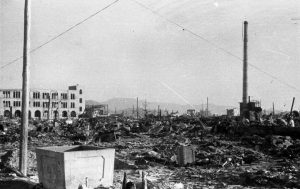Documenting Hiroshima of 1945: Around December, war victims demand public bathhouses
Dec. 20, 2024
by Kyosuke Mizukawa, Senior Staff Writer
Around December 1945, a smokestack stood alone amid the ruins of the central area of Hiroshima City, which was nearly void of all wooden houses and shops. There were also traces of a public bathhouse.
“Hakuun-roku,” (in English, ‘Record of white cloud’), a column carried in the Chugoku Shimbun on November 19, described “Hiroshima citizens’ inconveniences experienced since the ‘pika-don’ (an expression in Japanese used to describe the flash and blast from the bombing)” from the viewpoint of ordinary people. In the article, “Closure of public bathhouses” was an oft-raised point. At that time, people “wanted to take more frequent baths,” because “workplaces in the ruins were filled with more dust and debris than could have been imagined.” The column argued that people that had lost their homes and were living in dormitories and boarding houses felt the need more intensely.
On December 10, a written resolution was submitted to the Hiroshima Prefectural government that included such demands as “military barracks remaining at several sites in the city should be provided immediately and without charge to war victims for use as public bathhouses.” The Hiroshima War Victims’ Association had put together the resolution in the hopes of “securing a minimum quality of life for the war victims as soon as possible.”
The association had held a meeting for its founding in the area of Koi-cho (in Hiroshima’s present-day Nishi Ward) on December 7. “Honoo no Keifu” (‘Record of flames’), a feature article series published by the Chugoku Shimbun in 1965, reporting on association members such as Kyoichi Niida, who sat on the executive committee, indicated that the group had modeled itself after other associations of war victims already established in Tokyo and Osaka. The group was hoping to “save the war victims on our own power, because the government is not doing anything to help.”
On December 7, using megaphones, Mr. Niida and his colleagues called on passers-by on the streets to join the association, with a makeshift theater that served as the venue for the founding meeting said to have been packed to capacity. The resolution that the association submitted to the prefecture three days later also contained a demand to open military warehouses such as the former Hiroshima Army Ordnance Supply Depot (in Hiroshima’s present-day Minami Ward) as “communal housing,” amid the severe housing shortage in the city.
On December 12, two days after submission, the prefectural government provided its response to the resolution. As for the request of “public bathhouses,” the government decided that “two boilers owned by the military would be provided immediately at no cost.” Regarding the demand for warehouses, the government encouraged the association to contact departments in charge, indicating that warehouse buildings with no plans for utilization in the future would be immediately be made available to war victims.
(Originally published on December 20, 2024)
Around December 1945, a smokestack stood alone amid the ruins of the central area of Hiroshima City, which was nearly void of all wooden houses and shops. There were also traces of a public bathhouse.
“Hakuun-roku,” (in English, ‘Record of white cloud’), a column carried in the Chugoku Shimbun on November 19, described “Hiroshima citizens’ inconveniences experienced since the ‘pika-don’ (an expression in Japanese used to describe the flash and blast from the bombing)” from the viewpoint of ordinary people. In the article, “Closure of public bathhouses” was an oft-raised point. At that time, people “wanted to take more frequent baths,” because “workplaces in the ruins were filled with more dust and debris than could have been imagined.” The column argued that people that had lost their homes and were living in dormitories and boarding houses felt the need more intensely.
On December 10, a written resolution was submitted to the Hiroshima Prefectural government that included such demands as “military barracks remaining at several sites in the city should be provided immediately and without charge to war victims for use as public bathhouses.” The Hiroshima War Victims’ Association had put together the resolution in the hopes of “securing a minimum quality of life for the war victims as soon as possible.”
The association had held a meeting for its founding in the area of Koi-cho (in Hiroshima’s present-day Nishi Ward) on December 7. “Honoo no Keifu” (‘Record of flames’), a feature article series published by the Chugoku Shimbun in 1965, reporting on association members such as Kyoichi Niida, who sat on the executive committee, indicated that the group had modeled itself after other associations of war victims already established in Tokyo and Osaka. The group was hoping to “save the war victims on our own power, because the government is not doing anything to help.”
On December 7, using megaphones, Mr. Niida and his colleagues called on passers-by on the streets to join the association, with a makeshift theater that served as the venue for the founding meeting said to have been packed to capacity. The resolution that the association submitted to the prefecture three days later also contained a demand to open military warehouses such as the former Hiroshima Army Ordnance Supply Depot (in Hiroshima’s present-day Minami Ward) as “communal housing,” amid the severe housing shortage in the city.
On December 12, two days after submission, the prefectural government provided its response to the resolution. As for the request of “public bathhouses,” the government decided that “two boilers owned by the military would be provided immediately at no cost.” Regarding the demand for warehouses, the government encouraged the association to contact departments in charge, indicating that warehouse buildings with no plans for utilization in the future would be immediately be made available to war victims.
(Originally published on December 20, 2024)








